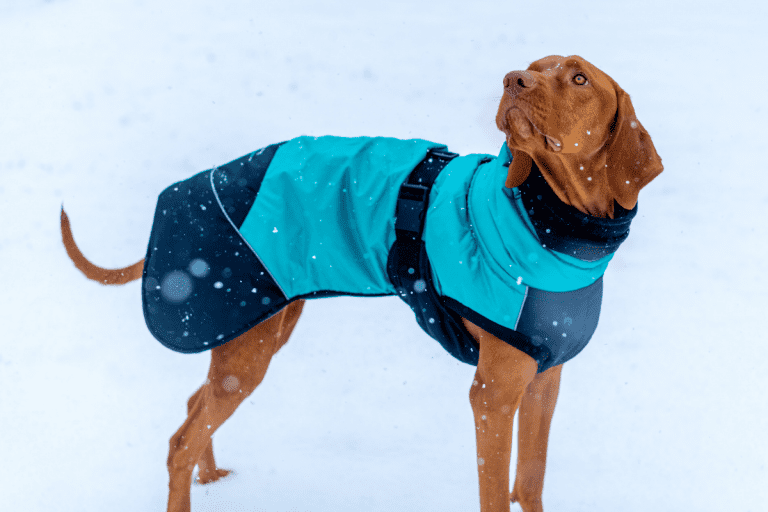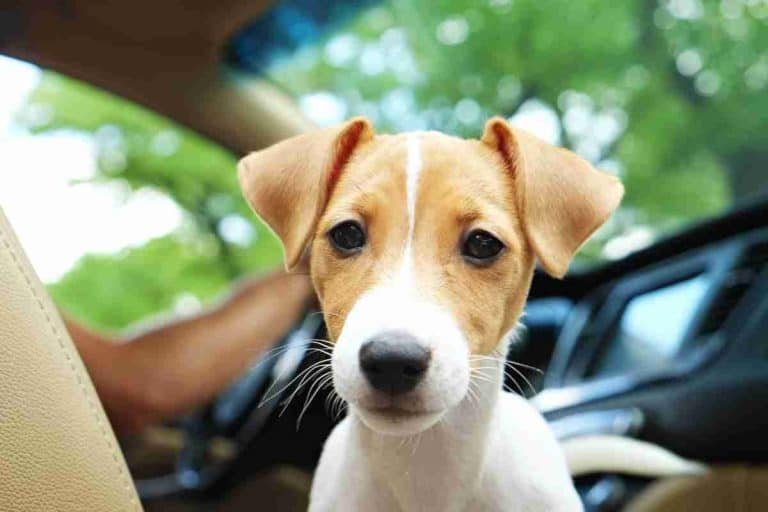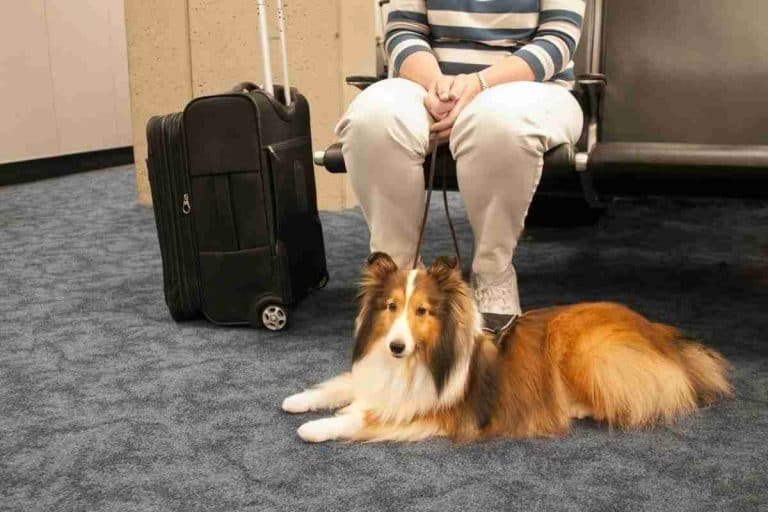9 Essential Tips for Safe, Comfortable Hammock Camping with Your Dog
Affiliate Disclaimer: As an affiliate, we may earn a small commission when you make a purchase from any of the links on this page at no additional cost to you!
Last Updated on October 14, 2025
Hammock camping with your dog becomes safe and comfortable when planning drives decisions. Campers choose stable trees, a low hang, and tree‑friendly straps. They verify leash policies, scan for ground hazards, and watch for wildlife signs. Weather, water, and nearby facilities shape a calm, convenient setup.
9 Essential Tips for Safe, Comfortable Hammock Camping with Your Dog cover smart campsite selection, durable hammocks and suspension, and a dog-focused packing list. They include training for entry and settling, sleeping arrangements, warmth and rain protection, and emergency readiness. Topics span underquilts, bug nets, safe tethering, first-aid plans, and Leave No Trace. Following them protects gear, respects neighbors, and helps dogs rest well.
Choose the right campsite and hang spot
Selecting a campsite for hammock camping with a dog requires prioritizing safety, comfort, and convenience. Aim for a level area with natural windbreaks and space for a low-slung hammock and a separate dog rest area. Avoid steep slopes, erosion-prone ground, and obvious water run-off paths. Choose trees at least 10–12 inches in diameter, healthy and free of dead limbs. Place the hammock where entering and exiting stays low — under 18 inches — to make transitions easier for a nervous or older dog. Keep the site close enough to restroom facilities and parking so quick trips with the dog don’t become long, stressful walks.
Consider visibility from trailheads and campsites. A tucked-in spot reduces wind and exposure, but it should remain visible enough to meet park rules and to allow quick access if wildlife appears. Practice a trial hang near home to test hammock height, strap positions, and a simple ramp or step plan for the dog. For additional travel and gear guidance relevant to multi-stop trips, consult Essential dog travel tips and gear for road trips. Reserve a site that matches leash and pet rules, and carry a compact, durable mat for the dog’s ground space.
Verify pet rules, leash policies, and campground restrictions
Confirm campground regulations before arrival. Many public lands and private campgrounds enforce leash lengths, breed restrictions, and limits on where pets can sleep. Some sites prohibit pets in certain loop areas or require dogs to remain within a specific distance of the campsite. Contact the ranger station or check the official park website for the most current policies. Violating posted rules can result in fines or eviction, so verify policies when booking and again on arrival.
Also ask about quiet hours, fire bans, and designated wildlife-safe food storage. Some facilities require dogs to be crated or tethered at night; others prohibit tethering that could endanger the animal. Carry a visible, up-to-date ID and proof of vaccinations. For examples of how retail and public policies vary and why checking rules matters, see Are dogs allowed in Cabela’s?. When in doubt, choose campgrounds with explicit pet-friendly designations.
Pick flat, hazard-free ground and stable trees for anchoring
Site-specific assessment prevents accidents. Walk the perimeter to spot roots, sharp rocks, ant beds, and glass. Clear debris from the dog’s resting patch and place a low, non-slip mat where paws can grip. Avoid areas under dead snags or trees with visible fungal growth. Test potential anchor trees by checking bark health and trunk stability; shake the trunk lightly and listen for hollow sounds. Use at least two healthy trees for a single hammock setup to reduce stress on any one tree.
Use wide, tree-friendly straps to protect bark and distribute load. Position straps at a 30-degree angle and set the hammock so the lowest sag point sits low enough for the dog to step into and out of comfortably. Keep suspension hardware out of the dog’s reach and fasten loose ends neatly. If the dog tends to chew gear, provide a chew-safe tether or short leash secured to a stake or low tree limb while the dog rests. For tips on secure setups and adapting secure practices to pet gear, refer to 5 ways to secure a dog crate in car.
Consider weather, wildlife risk, and proximity to water
Microclimate and local wildlife affect site choice. Check the forecast for wind, temperature swings, and precipitation. Choose a site above potential flood zones and away from seasonal streams. In summer, select partial shade to prevent overheating. In cold weather, pick a spot that minimizes wind exposure and allows for a low-warmth setup beneath the hammock.
Assess wildlife activity: avoid campsites with heavy rodent signs or recent predator tracks. Store food and scented items in approved lockers or bear canisters away from the hammock. Keep the dog leashed or crated at night to reduce encounters. Water access can be a plus, but avoid fast-moving or steep shorelines. Bring a canine life jacket for crossings and supervise any water play. For guidance on providing safe water options and cooling gear for dogs at campsites, see 10 refreshing puncture-proof dog pools. Check local advisories and adjust the site if conditions or wildlife signs change.
Select a hammock and suspension that fit you and your dog
Choosing the right hammock and suspension starts with honest measurement and realistic load planning. A shared hammock must accommodate two bodies plus overnight gear and movement. Aim for a hammock width of at least 60 inches for most adult-and-dog pairs; taller people may prefer 9–10 foot hammocks for comfortable foot clearance. Check the manufacturer’s weight rating and then add a safety margin of 25–50 percent to account for a shifting dog and dynamic forces when the dog climbs in or paw at the fabric.
Material and suspension choices matter equally. Lighter parachute nylon offers packability but often uses lower denier fabric than heavier duty models. For frequent use with a dog, prioritize higher denier or reinforced fabrics and robust suspension systems with wider tree straps to protect trees and reduce abrasion to the webbing.
Before buying, compare product specs, seam construction and available replacement covers. Readers who want a broader view of travel gear for pets can consult Essential dog travel tips and gear for road trips for gear-selection guidance. A quick CTA: verify combined weight ratings and suspension specs before the first overnight trip.
Size, weight rating and material choices for shared sleeping
Calculate total load by summing the person’s weight, the dog’s weight and typical overnight items. Add a dynamic multiplier of 1.5 to 2.0 to cover movement and sudden shifts. If combined weight equals 300 lb, choose a hammock and suspension rated for at least 450–600 lb. Manufacturers sometimes publish static tests—confirm whether ratings include dynamic testing.
Length and width decisions depend on sleeping position and dog habit. Dogs that sprawl need extra width; dogs that curl may fit less space. Look for hammocks labeled “double” or “family” for shared sleeping.
Material choices influence longevity. Denser fabrics (higher denier nylon or polyester) and reinforced stitching handle repeated stress better than ultralight 30D parachute nylon. Prioritize hammocks with sewn ridgelines, boxed ends, and reinforced attachment points. If weight is critical, select a model with a higher-rated suspension and a moderately heavier hammock body to balance durability and packability.
For a deeper look at durable travel gear options, review product comparisons such as Best dog crates for car travel in 2023: a comprehensive review.
Durable fabrics and options that resist claws and dirt
Durability starts with fabric choice and finishes with protective layers. Materials like Cordura, 210D nylon, or coated polyester resist abrasion and hold up to scratching better than lighter 30D parachute fabrics. Look for ripstop weaves and reinforced seams at anchor points.
Finishes also help. PU coatings, silicone treatments, or durable water repellent (DWR) finishes slow dirt and water penetration. For muddy terrain, a removable, washable hammock liner or a heavy-duty cover extends the hammock’s life and simplifies cleaning. Consider a thin, tough pad or blanket between the dog and the hammock to protect the shell from claws and oils.
Grooming choices reduce wear. Keeping nails trimmed and using lightweight booties on rough ground cut down on punctures. For muddy or wet dogs, a quick wipe or compact towel prevents ground grit from embedding in the fabric. For guidance on waterproof and protective pet gear, see waterproof dog coats with underbelly protection.
Tree-safe straps, carabiners and calculating combined load
Use tree-friendly straps at least 1 inch wide to spread load and protect bark. Wider webbing reduces pressure and meets many park regulations. Choose straps long enough to wrap and fine-tune height—5 to 8 feet usually offers needed flexibility. Avoid thin cord or improvised webbing that can cut into trees or fail under shock.
Select hardware rated above the expected maximum load. Aluminum or steel carabiners marked with strength ratings (kN) or pound ratings provide clear performance data. Avoid non-rated “galvanized” clips from discount sources. Locking carabiners add security when a dog shifts suddenly.
To calculate a safe system rating, sum user + dog + gear, then multiply by a dynamic factor of 1.5–2.0. Choose straps and carabiners rated higher than that total. Inspect all attachment points for wear before each trip and retighten or replace webbing with visible abrasion or frayed stitching. For tips on securing pet gear and testing restraint systems, consult practical guides like 5 ways to secure a dog crate in car.
9 Essential Tips for Safe, Comfortable Hammock Camping with Your Dog
Pack a dog-focused gear list
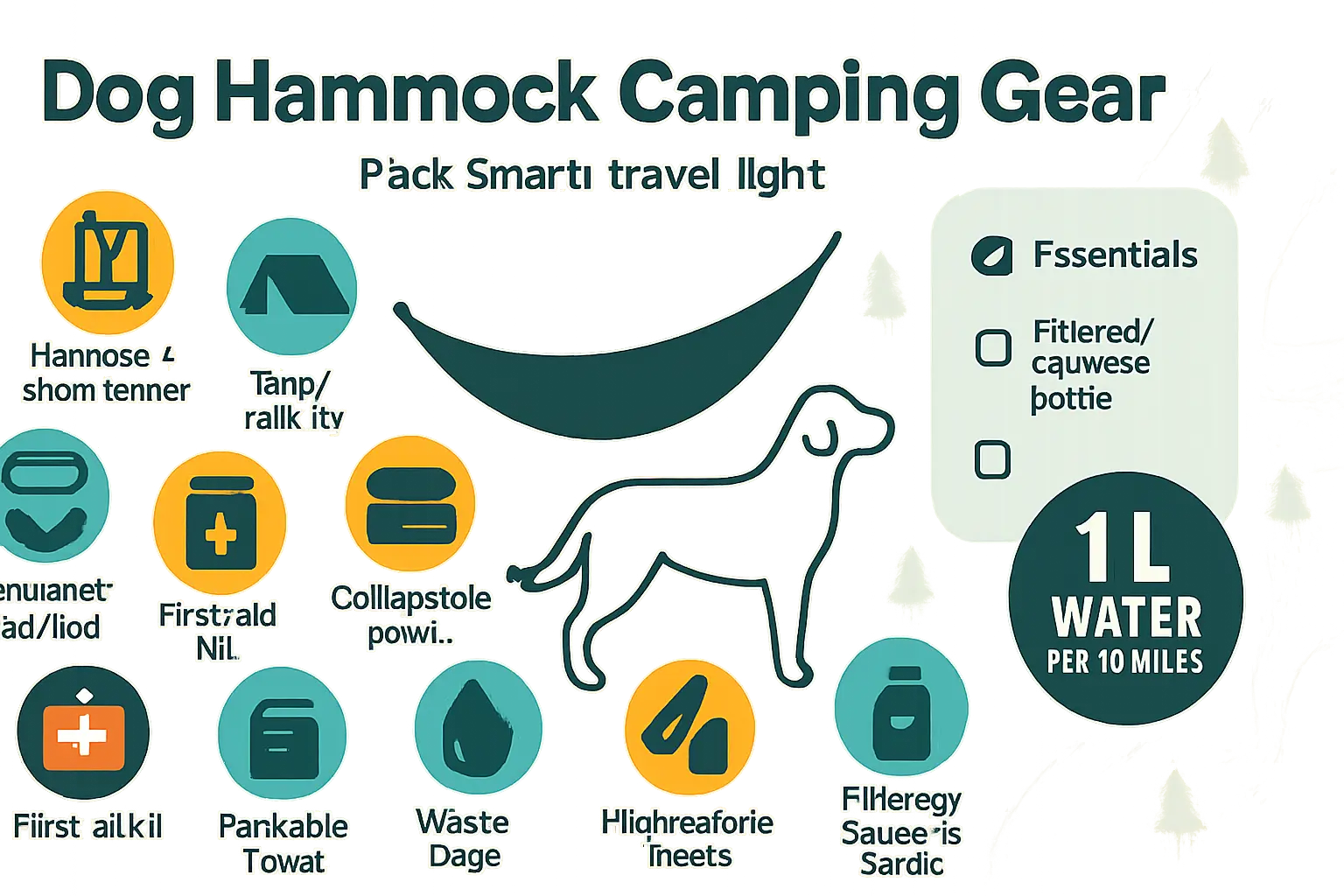
Hammock camping requires a targeted gear list for canine comfort and safety. Prioritize items that protect against cold, wetness, and ground hazards while keeping weight manageable. Include a harness that attaches securely to the hammock suspension and a short tether to prevent slips or sudden jumps. Add a lightweight, insulated dog sleeping pad for use when the dog sleeps beside the hammock or on the ground during breaks. Bring a packable towel and waste bags for quick cleanups. Store food in an airtight container to avoid wildlife attractants, and keep medications and records in a waterproof pouch.
For broader travel gear and packing pointers, consult this essential dog travel tips and gear for road trips. Review that checklist before final packing to avoid forgotten must-haves. A final pre-hike check should confirm fit, function, and familiarity with each item.
Nighttime essentials: bed, blankets, underquilt/top quilt, rain protection
Night comfort determines how well a dog rests and recovers. A dog-specific hammock pad or small bed that fits the hammock floor reduces sliding and creates a stable surface. Add an insulated blanket or dog sleeping bag for breeds that lose heat quickly. For colder nights, an underquilt or top quilt beneath the human hammock helps retain shared warmth; secure the dog’s bedding so it won’t shift.
Rain protection must cover both the hammock and a dry space for the dog to shelter. Use a tarp large enough to extend past the hammock and stake or tie guylines to deflect wind-driven rain. Consider a waterproof dog coat with underbelly protection for short outings from the shelter; see this guide on waterproof dog coats with underbelly protection for fit and material tips.
Hydration, food, bowls and extra calories for active days
Hydration strategy reduces risk of heat stress and fatigue. Pack at least one liter of water per 10 miles for an active dog, plus a spare supply for emergencies. Use collapsible bowls that stow flat and a squeeze bottle or filtered system for refills. Freeze part of the water supply when possible to extend cooling on hot days.
Calorie needs rise with activity. Bring calorie-dense kibble or shelf-stable toppers for energy boosts. For long or high-exertion hikes, add high-quality treats or recovery chews to replenish glycogen between breaks. Store food in odor-proof containers and ration by planned mileage. For ideas about portable water options and keeping dogs refreshed, see this piece on 10 refreshing puncture-proof dog pools.
Health items: first-aid, vaccines, flea/tick prevention, meds
A compact canine first-aid kit proves invaluable. Include bandage material, antiseptic wipes, scissors, tweezers for ticks, wound dressing, and a blanket for shock. Add a digital thermometer and a syringe for accurate oral dosing. Pack any prescribed medications in original labeled containers and note dosages.
Verify vaccinations and carry proof if travel crosses jurisdictional boundaries. Apply veterinary-approved flea and tick prevention before the trip. Learn proper tick removal technique and check the dog frequently during hikes. For motion-related or situational anxiety, explore calming strategies and remedies recommended in 9 natural ways to remedy your dog’s travel anxiety. Finally, save the nearest emergency-vet contact and medical history in both digital and printed forms.
Train and acclimate your dog before the trip
Before hammock camping, the dog must know basic obedience and feel comfortable off the ground. Start acclimation weeks before departure. Schedule a veterinary check and confirm vaccinations and parasite prevention. Introduce the hammock gear at home so the fabric, clips, and straps become familiar objects. Use short, frequent sessions and reward calm behavior with treats and praise.
Focus on three practical goals: confident movement on and off the hammock, relaxed settling for naps and sleep, and reliable responses to recall and leash cues in outdoor settings. Plan progressive exposures: living room, backyard, quiet park, then busier trails. Keep training sessions under ten minutes to avoid stress.
Owners can pair these steps with broader travel-calming strategies. The guide on natural ways to remedy your dog’s travel anxiety offers complementary techniques for reducing stress before and during trips.
CTA: Book a short overnight at a nearby campsite to test gear and routines before committing to remote trips.
Step-by-step at-home hammock introduction and slow progression
Begin with a low, secure hammock or fabric hammock substitute placed close to the floor. Allow the dog to sniff and inspect the material. Reward voluntary interaction with high‑value treats. Next, encourage the dog to place a paw on the edge, then both front paws, using a treat as a marker.
Progress only when the dog shows calm confidence. Raise the hammock a few inches and repeat short sessions. Use a non-slip blanket or mat in the hammock so the dog senses traction. Give a steady cue, such as “up” for entry and “settle” for lying down, and reward consistency.
Introduce movement gradually. Gently lift the hammock a few inches while the dog lies down, pause, then lower. Increase motion slowly so the dog tolerates sway. For dogs that resist, break steps into smaller increments and extend repetition at each level.
Combine this at-home routine with general travel prep tips from essential dog travel tips and gear for road trips to ensure equipment and packing decisions support training progress.
Practice entry/exit, settling down, and using nets or enclosures
Teach reliable entry and exit mechanics before the first campsite. Practice directional cues: “front up” and “rear up” if the dog needs to use a specific approach. Reward precise placement of paws and steady posture. Rehearse exits by asking for a calm stand, then stepping down on command.
Train settling routines so the dog associates the hammock with rest. Use a familiar bed pad and a favorite toy. Reinforce a single sleeping position with a cue such as “bed” or “settle.” Gradual night practice in a quiet room reduces surprises at camp.
If using bug nets or enclosures, introduce zippers and closures slowly. Let the dog explore the enclosed space while unzipped. Progress to brief zipped sessions with the owner nearby, building duration using treats.
For larger dogs or dogs that need assistance, rehearse safe lifting and handling techniques. The post on 5 steps to safely lift a large dog into a car offers practical body mechanics and handling tips applicable when helping a dog onto a raised hammock.
Reinforce recall, stay and leash manners in outdoor settings
Reliable recall and stable leash manners keep hammock camping safe. Begin recall training on a short longline in low-distraction areas. Reward instantly with high-value treats and vary rewards so the dog stays motivated outdoors. Practice emergency recall with a distinct cue the dog hears only for urgent returns.
Work “stay” in increasingly challenging environments. Add mild distractions, then progressive distance, and finally elevation changes like short slopes and logs. Proof the stay cue while the hammock sways lightly to simulate campsite conditions.
Polish leash manners using a well-fitted harness. Train loose-leash walking, rewarding the dog for returning focus and pace. Practice tethering to a secure line and teaching the dog to settle when tethered. These sessions prevent frantic movement near the hammock and campsite hazards.
For guidance on safe tethering and restraint methods that travel well, see the advice on how to secure a dog in car with leash. Regular, short outdoor training sessions build reliability for real camping conditions.
Plan sleeping arrangements for comfort and safety
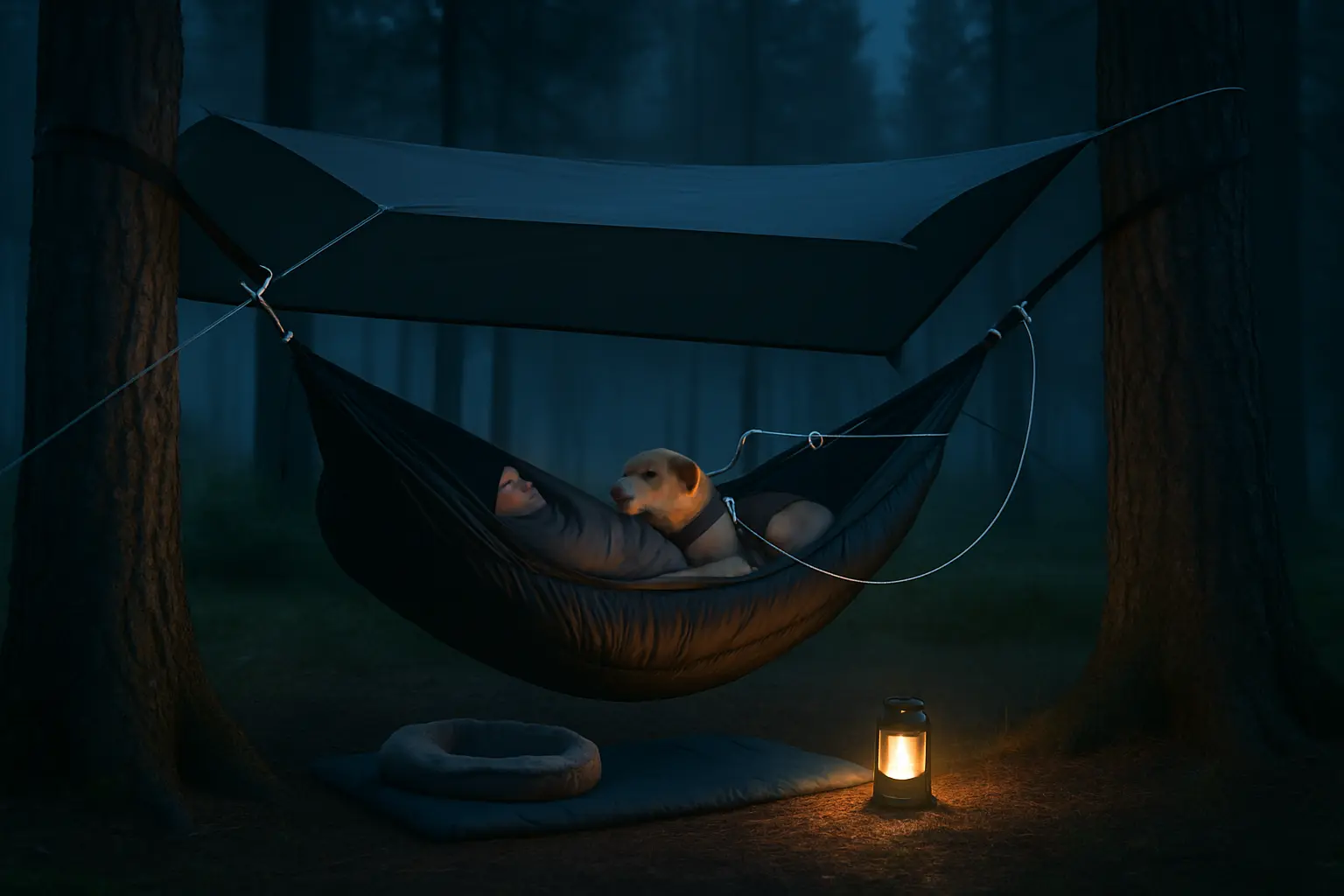
Thoughtful sleeping arrangements keep both dog and owner safe and well-rested. Assess the dog’s size, mobility and temperament before pitching the hammock. Small dogs tolerate close proximity and may prefer curling by the chest. Medium and large dogs need more space and clearer escape routes. Reserve a low hang for overnight use to reduce fall risk and make entry easier.
Use gear that matches the plan: a sturdy hammock rated for combined weight, a climbing-rated suspension system, and a short tether or harness to keep the dog from wandering in the dark. If the dog tends to shift at night, add a non-slip liner or lightweight divider to reduce sliding.
Designate a backup ground spot and pack a compact insulated pad and tarp in case the dog cannot safely share the hammock. For broader dog travel and gear guidance that applies to hammock nights, consult this essential dog travel tips and gear for road trips. Review that gear list before camping to ensure a consistent, safety-focused setup.
Sharing the hammock: positioning by dog size and lowering the hang
Positioning within the hammock changes comfort and safety. For small dogs, place them near the chest or upper torso. Close proximity eases anxiety and helps the dog feel secure. For medium dogs, keep them toward the middle so weight distributes evenly. For large dogs, avoid full sharing when possible; consider alternating hammock nights or setting a ground shelter.
Lower the hang before settling. A lower hang reduces fall distance and makes entry and exit easier. Keep the suspension slightly slack to lower the center of gravity, but maintain enough tension to avoid sagging that traps paws. Use a short, padded harness and clip a short tether to the hammock’s tie-in point to prevent sudden slips.
Teach clear cues for climbing up and down during daytime practice. If the dog needs assistance, follow safe lifting techniques similar to those used when helping heavy dogs into vehicles. See this guide on 5 steps to safely lift a large dog into a car for maneuvering tips that transfer to hammock handling.
Ground setup: insulated pad, tarp, and covered sleeping spot
When sharing the hammock proves unsafe, a prepared ground setup keeps the dog comfortable. Choose a level, dry spot clear of roots and rocks. Lay an insulated pad beneath the dog to prevent conductive heat loss. Closed-cell foam works for resilience; inflatable pads add comfort but require repair gear.
Pitch a tarp to create a defined, covered sleeping spot. Set the tarp low on the windward side to deflect breeze and channel runoff. Stake the tarp edges and create a small vestibule for gear and a dry dog bed. Carry a fast-dry blanket to line the pad for added warmth and to wick moisture away from fur.
For owners who prefer a sheltered enclosure, a crate or portable kennel can serve as a secure, covered spot on the ground. For options and sizing guidance, review this best dog crates for car travel to adapt crate concepts for campsite use. Stow wet gear separately to maintain a dry sleeping area.
Tips to keep both of you warm and dry overnight
Layering and targeted insulation keep the pair warm and dry through temperature swings. The owner should use an underquilt or quality sleeping pad under the hammock. Add a top quilt rated for expected low temperatures. For the dog, a well-fitting waterproof coat with belly protection blocks wind and rain and preserves core heat.
Keep paws dry and debris-free by using short booties on rough terrain and a microfibre towel for a quick dry before bed. Place a moisture-wicking blanket or dog sleeping bag on top of the pad to trap heat. Avoid direct heat sources and chemical warmers next to the dog; they pose burn risks.
Monitor for hypothermia signs: shivering, lethargy, shallow breathing. If either shows symptoms, move to a warmer shelter and increase body contact while insulating both from the cold ground. For coat options that improve overnight dryness and warmth, explore this guide to waterproof dog coats with underbelly protection. Ensure sizes and fastenings allow natural movement during sleep.
Protect your kit and care for your dog
Hammock camping with a dog demands attention to both gear integrity and the dog’s comfort. Small problems, like loose stitching or muddy paws, escalate quickly on multi-day trips. The owner should prioritize simple, repeatable routines that prevent fabric damage and keep the dog healthy. Regular checks and lightweight protective upgrades save time and reduce risk on the trail.
Trim nails, groom to reduce dirt/ticks, and consider booties
Short nails reduce snagging on hammock fabric and make climbing in safer. A basic grooming session before departure cuts loose hair and removes debris that would otherwise soil the hammock. For rough terrain or cold nights, consider durable dog booties that fit well and have good traction. Introduce booties gradually at home so the dog accepts them on the trail.
Use protective layers (blanket or liner) to protect hammock fabric
A washable hammock liner or a thin camping blanket creates a barrier against claws, wet fur, and dirt. Choose ripstop or polyester liners with reinforced seams. Secure the liner to the hammock with small clips or a corner tuck so it cannot shift when the dog moves. Opt for liners that add minimal weight but provide insulation and easy washing.
Clean-up, washing and quick maintenance on the trail
Carry a small repair kit: needle, thread, fabric tape, and a multi-tool. For routine cleanup, pet-safe wipes and a compact brush remove mud and seeds. Spot-wash the liner or blanket with biodegradable soap and rinse at a distance from water sources. For minor hammock tears, apply fabric tape immediately and schedule a full repair at camp. For more general travel gear and dog care ideas, consult essential dog travel tips and gear.
Keep your dog secure and be courteous at camp

A calm, safe dog makes hammock camping easier for everyone. Prioritize secure anchoring, considerate behavior, and minimal impact on wildlife. Use gear and routines that prevent escapes, reduce noise, and keep the campsite clean.
Safe tethering options: longline, ridgeline tie or hand-held leash at night
Choose a tether that matches the dog’s size and training. A longline (10–20 feet) gives freedom while keeping the dog near camp. Clip a longline to a harness, never a collar, to avoid neck injuries. A low ridgeline loop lets the dog rest off the ground without tangling the hammock. For nervous or untrained dogs, a short hand-held leash at night lets an owner respond immediately.
- Inspect webbing and hardware before use.
- Keep tethers away from hammock suspension and cooking areas.
- Use quick-release knots or hardware to free a dog fast in an emergency.
Control barking, pick up waste, and respect neighbors
Quiet camps reduce conflict. Train basic cues like quiet and reward calm behavior. Offer exercise and chew toys to prevent boredom-related barking. Always carry waste bags and pack out feces; burying is not acceptable in high-use areas. Keep dogs leashed near other campers and ask permission before allowing interactions. These habits preserve goodwill and reduce campsite disturbances.
Minimize wildlife interactions and follow Leave No Trace
Secure all food and scented items in bear canisters or locked vehicles. Never feed wildlife or allow a dog to pursue animals. Keep scented gear—trash, dishes, toothpaste—sealed and elevated. Tether dogs away from trails and food prep zones to limit curious wildlife encounters. Follow Leave No Trace: pack out trash, remove all waste, and restore any disturbed ground. For practical gear recommendations and travel-ready options, see essential dog travel tips and gear for road trips.
Prepare for emergencies and common problems
Hammock camping with a dog requires planning for likely injuries, separation events, and comfort failures. Pack targeted supplies, memorize basic responses, and set up redundancy so a single mishap does not end the trip.
Basic dog first-aid steps and vet/emergency contact plan
Carry a canine first-aid kit with bandages, antiseptic, tweezers, a muzzle or soft wrap, and any prescription meds. If the dog bleeds, apply direct pressure and elevate the wound when possible. For suspected fractures, immobilize the limb with a splint or rolled towel. Treat for shock by keeping the dog warm and calm. Know basic canine CPR techniques and practice them beforehand. Before departure, list the nearest emergency vet clinics along the route and save each number in the phone and on a laminated card. Share the card with trip companions and leave a copy with someone at home. Consider downloading a vet locator app for off-grid weekends.
Lost-dog prevention: ID tags, microchip and GPS trackers
Use a sturdy collar with up-to-date ID tags and a securely registered microchip. Attach a lightweight GPS tracker to the collar for remote locations. Take clear photos of the dog from multiple angles before each trip. When setting up camp, tether the dog safely to an anchor or use a short stakeout line so curious wildlife doesn’t pull them off. For more gear and travel tips, see essential dog travel tips and gear for road trips.
Solutions when your dog won’t hammock, is too large, or gets cold
Introduce hammock use with short, reward-based sessions at home. If the dog refuses, offer an adjacent elevated cot or insulated pad. For large dogs, use wide, reinforced hammocks or set up two hammocks side-by-side with a low bridge. To prevent chill, equip the dog with an insulated coat, a canine sleeping bag, or a closed-cell foam pad under their weight-bearing areas. Lower the hammock close to the ground and shield it from wind with a tarp when temperatures drop. If the dog panics in a hammock, move them to a safer, familiar surface and resume gradual training later.
Summary
This guide equips campers with clear, safety-first strategies for hammock camping with a dog. It covers how to choose a safe hang spot, verify pet policies, and select durable, dog-friendly hammocks and suspensions that handle dynamic loads. Readers learn to pack canine essentials, train and acclimate their dogs to hammock movement, and tailor sleeping arrangements—shared or ground—to size, temperament, and weather.
Practical checklists for warmth, hydration, first aid, and emergency prep round out the plan, along with campsite etiquette, wildlife precautions, and gear-protection habits. Follow these steps to create a low-risk, comfortable setup that helps both camper and dog rest well and enjoy the trip.
Key Takeaways
- Choose a safe hang: Use healthy trees (10–12+ inches diameter), wide tree-friendly straps, and a low hang (ideally under 18 inches) for easier dog entry and reduced fall risk.
- Match gear to load: Select reinforced fabrics and rated hardware; calculate combined weight (human + dog + gear) and multiply by 1.5–2.0 to pick hammocks, straps, and carabiners with adequate safety margin.
- Pack dog-specific essentials: Harness and short tether, insulated pad/bed, tarp coverage, rain layer, towel, waste bags, first-aid items, and extra calories; plan at least 1 liter of water per 10 miles for active dogs.
- Train before you go: Practice low, gradual hammock introductions, reliable entry/exit, calm settling, and solid recall, stay, and leash manners in outdoor settings.
- Plan sleep strategically: Position small dogs near the chest, keep medium dogs centered, avoid full sharing with large dogs when unsafe, and prepare a warm, covered ground setup as a backup.
- Be prepared and courteous: Trim nails, use liners to protect fabric, control noise, manage waste, secure food and scents, and carry first-aid, ID, microchip, and GPS for emergencies.
FAQ
- What hammock size and rating work best when sharing with a dog? Aim for at least 60 inches wide (double/family models) and choose a system rated for 1.5–2.0 times the combined weight of person, dog, and gear. Prioritize higher-denier fabric and reinforced stitching for repeated use.
- How low should the hammock hang for a dog’s safe entry and exit? Keep the lowest sag point under 18 inches to reduce fall distance and make step-ups easier, especially for older or nervous dogs. Maintain a slight sag for stability without trapping paws.
- How can campers keep a dog warm and dry overnight? Use an insulated pad or dog sleeping bag, a moisture-wicking blanket, and a tarp that fully covers the rest area. Add a well-fitting waterproof coat with belly protection and dry paws before bed.
- Why verify campground pet rules before booking? Policies vary on leash lengths, tethering, and where pets can sleep; violations can lead to fines or eviction. Checking rules ensures the chosen site allows a safe, compliant setup.
- How should a dog be introduced to hammock camping? Start at home with a very low hammock, reward calm interactions, and gradually add height and sway. Practice cues for entry, exit, and settling, and introduce nets or enclosures slowly.


